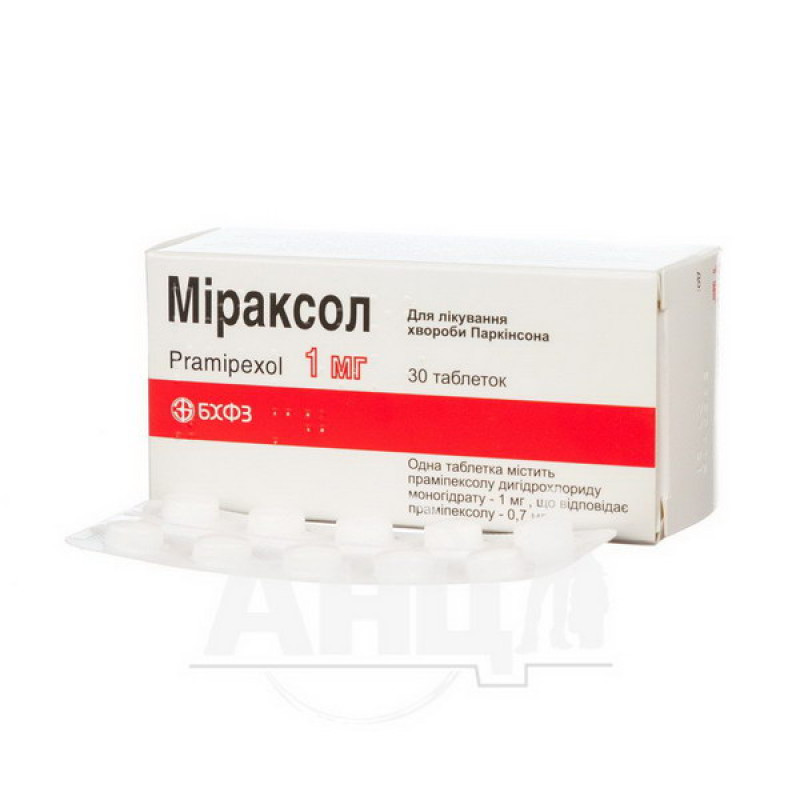Miraxol tablets 1 mg blister No. 30

Miraxol tablets are indicated for the following indications:
Treatment of symptoms of idiopathic Parkinson's disease in adults, as monotherapy (without levodopa) or in combination with levodopa throughout the course of the disease until the late stages, when the effect of levodopa is reduced or becomes unstable and there is suspicion of a therapeutic effect (the phenomenon of "on-off"). Symptomatic treatment of idiopathic "restless legs" syndrome of moderate to severe severity in adults (doses not higher than 0.75 mg).Composition
Active ingredient: pramipexole dihydrochloride monohydrate;
1 tablet contains 0.25 mg or 1.0 mg of pramipexole dihydrochloride monohydrate, corresponding to 0.18 mg or 0.7 mg of pramipexole;
Excipients: pregelatinized starch, mannitol (E 421), povidone, colloidal anhydrous silicon dioxide, magnesium stearate.
Contraindication
Hypersensitivity to pramipexole or any other component of the drug.
Method of application
The tablets should be taken orally with water, with or without food. The daily dose should be divided into 3 equal doses.
Application features
Pregnant women
The drug can be used during pregnancy only if the expected benefit to the woman outweighs the potential risk to the fetus.
Children
Parkinson's disease. The safety and efficacy of pramipexole in children (under 18 years of age) have not been established. There is no evidence to support the use of pramipexole in children with Parkinson's disease.
Restless legs syndrome: Pramipexole is not recommended for use in children (under 18 years of age) due to insufficient data on safety and efficacy.
Tourette syndrome: Pramipexole should not be used in children (under 18 years of age) with Tourette syndrome due to the negative benefit/risk ratio for this condition.
Drivers
Pramipexole may have a significant influence on the ability to drive or use machines. Hallucinations or drowsiness may occur.
Patients with drowsiness and/or episodes of sudden onset of drowsiness while taking pramipexole should refrain from driving and from potentially hazardous activities where impaired attention increases the risk of serious injury or death.
Overdose
There is no clinical experience of significant overdose.
Symptoms: Expected side effects related to the pharmacodynamic profile of a dopamine agonist include nausea, vomiting, hyperkinesia, hallucinations, agitation, and hypotension.
Treatment. There is no known antidote for dopamine agonist overdose. Neuroleptics may be administered if signs of central nervous system excitation occur. Patients with overdose may require general supportive measures including gastric lavage, administration of activated charcoal, intravenous fluids, and electrocardiogram monitoring.
Side effects
In patients with Parkinson's disease treated with pramipexole, the most common adverse reactions were nausea, dyskinesia, hypotension, dizziness, somnolence, insomnia, constipation, hallucinations, headache and fatigue.
Interaction
The concomitant use of antipsychotic drugs (neuroleptics) with pramipexole should be avoided if antagonistic effects are expected.
Cimetidine reduces the renal clearance of pramipexole by approximately 34%, probably by inhibiting the cationic renal tubular secretion transport system.
Storage conditions
Store in the original packaging at a temperature not exceeding 25 °C.
Keep out of reach of children.
Shelf life - 2 years.
There are no reviews for this product.
There are no reviews for this product, be the first to leave your review.
No questions about this product, be the first and ask your question.









